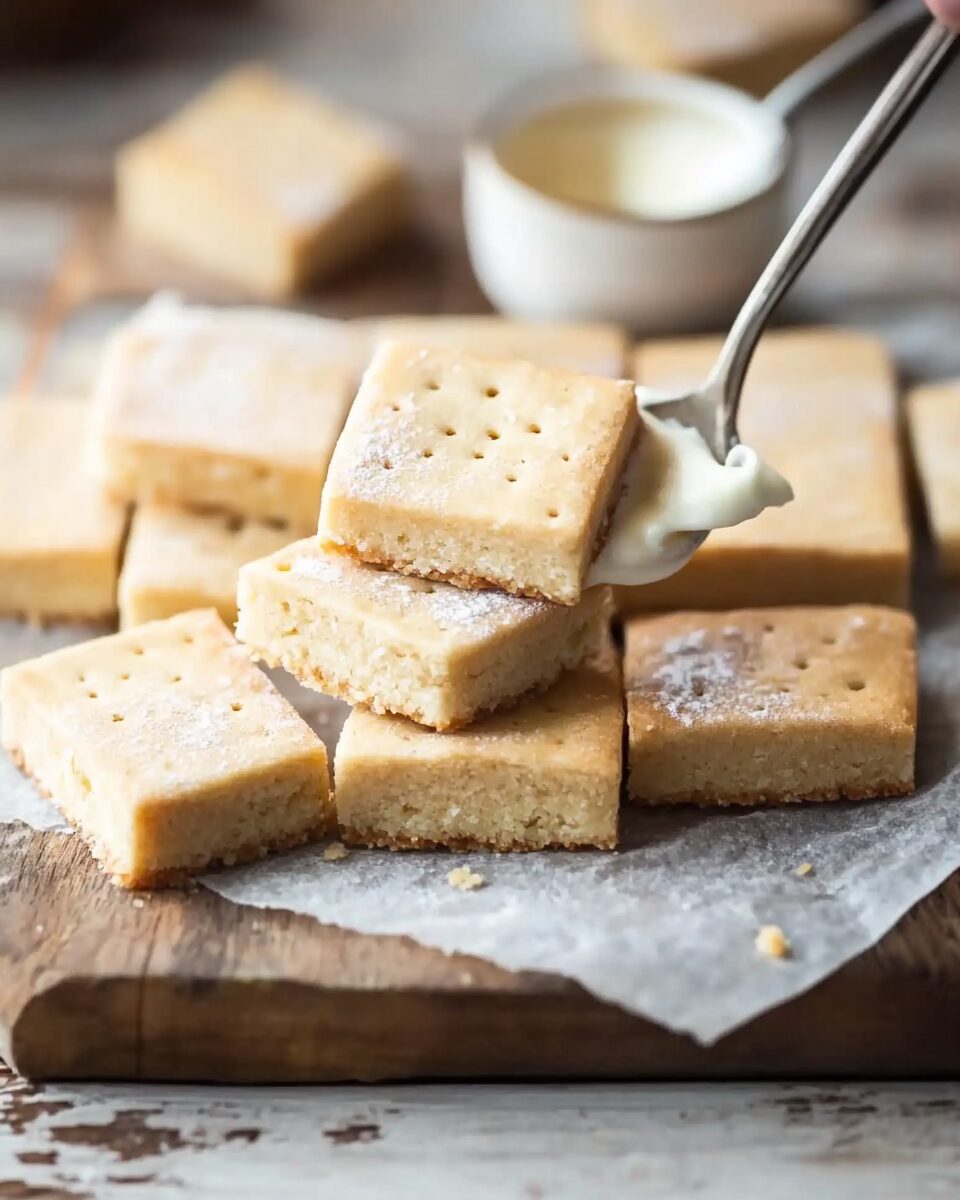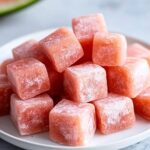Cornish Clotted Cream Shortbread is a luxurious twist on traditional Scottish shortbread, incorporating rich clotted cream alongside butter for an extra tender and melt-in-your-mouth texture. This indulgent treat pairs perfectly with tea and makes a delightful addition to any afternoon snack or dessert spread.
Full Recipe:
Ingredients
- 2 1/2 cups all-purpose flour
- 1/2 cup oat flour
- 5 tbsp cornstarch
- 1/2 cup granulated sugar (plus extra for sprinkling)
- 6 ounces clotted cream
- 2 ounces butter (4 tbsp), melted
Directions
- Preheat the oven to 350°F (175°C). Line an 8×8-inch baking pan with parchment paper for easy removal (optional).
- In a food processor, combine the flours, sugar, and cornstarch. Pulse to mix well.
- Add the clotted cream and melted butter to the bowl and process until the mixture forms coarse crumbs with no dry flour remaining.
- Transfer the crumbly dough into the prepared pan, pressing it down evenly with your hands to form a smooth surface. Prick all over with a fork and sprinkle with granulated sugar.
- Bake for approximately 22 minutes, or until the edges start to turn a pale golden color. The shortbread will still be relatively light in color.
- Let the shortbread cool slightly, then use a sharp knife to cut into squares while still warm for cleaner edges.
- Optionally, sprinkle more sugar on top before serving.
Nutrients (Per Serving, Approximate)
- Calories: 281
- Carbohydrates: 36g
- Protein: 4g
- Fat: 14g
- Saturated Fat: 8g
- Cholesterol: 33mg
- Sodium: 32mg
- Potassium: 60mg
- Fiber: 1g
- Sugar: 10g
- Vitamin A: 175 IU
- Calcium: 16mg
- Iron: 1mg
What Makes Cornish Clotted Cream Shortbread Special?
This shortbread differs from traditional versions in a few key ways:
- Clotted Cream Enrichment: Unlike regular shortbread, which relies solely on butter, this recipe includes Cornish clotted cream, adding an extra level of richness, silkiness, and tenderness.
- Melt-in-Your-Mouth Texture: The addition of cornstarch and oat flour ensures that the shortbread crumbles delicately with every bite, making it even more luxurious.
- Delicate Sweetness: With just the right amount of sugar for balance, this shortbread isn’t overly sweet, allowing the deep dairy flavors of the clotted cream and butter to shine.
- Simple Yet Elegant: Made with only a handful of high-quality ingredients, this shortbread is effortlessly elegant and perfect for entertaining.
The Importance of Clotted Cream in This Recipe
Clotted cream is a staple of Cornish and Devonshire cuisine, prized for its thick, velvety texture and intense dairy flavor. It’s traditionally made by slowly heating full-fat cow’s milk, which allows the cream to rise to the top and form a rich, golden crust.
In shortbread, clotted cream adds:
- An incredibly tender texture that’s softer and richer than standard shortbread.
- A deep, slightly caramelized dairy flavor that enhances the butteriness of the cookies.
- A smooth, creamy consistency that makes the dough easier to work with.
Using authentic Cornish clotted cream gives the best results, but if you can’t find it, you can substitute with extra butter mixed with a little heavy cream—though the distinctive clotted cream flavor will be missing.
The Role of Oat Flour in Shortbread
Traditional shortbread relies solely on all-purpose flour, but this recipe incorporates oat flour to enhance both flavor and texture.
Why use oat flour?
- Adds a hint of nuttiness that complements the creamy richness of the clotted cream.
- Improves the crumb structure, making the shortbread even more delicate and tender.
- Creates a softer, melt-in-your-mouth texture, making each bite more satisfying.
If you don’t have oat flour, you can easily make your own by pulsing rolled oats in a food processor until finely ground. Alternatively, you can substitute with more all-purpose flour, though you’ll miss out on the subtle nutty undertones.
Achieving the Perfect Shortbread Texture
The key to perfect shortbread lies in the ratio of ingredients and baking technique. Here’s how to ensure your shortbread has that signature tender, crumbly bite:
- Use High-Quality Butter and Clotted Cream: Since this recipe relies on dairy for its flavor, using good-quality, high-fat butter and authentic clotted cream makes a noticeable difference.
- Mix Until Crumbly, Not Overworked: Overmixing develops gluten, making shortbread too firm or chewy. The dough should be crumbly but still hold together when pressed.
- Bake Low and Slow: Shortbread is best baked at a moderate temperature (350°F/175°C) until just lightly golden. Overbaking can cause it to lose its delicate texture.
- Cut While Warm: To achieve clean, sharp edges, slice the shortbread into squares or fingers while it’s still warm but not hot.
Following these techniques ensures that your shortbread has the perfect crisp-yet-tender consistency.
Serving Suggestions for Cornish Clotted Cream Shortbread
Shortbread is an incredibly versatile treat, and there are many delicious ways to enjoy it:
- With Afternoon Tea: Serve alongside a pot of Earl Grey, Darjeeling, or English Breakfast tea for a traditional British experience.
- As a Dessert Accompaniment: Crumble over ice cream, custards, or fresh berries for a sophisticated finish.
- With Lemon Curd or Jam: The buttery richness pairs beautifully with tart, fruity spreads.
- Dipped in Chocolate: For a decadent twist, dip half of each shortbread piece in melted dark or white chocolate.
- Paired with Clotted Cream and Honey: Double down on the creaminess by serving with a spoonful of extra clotted cream and a drizzle of honey.
Whether enjoyed plain or with accompaniments, this shortbread is a true delight.
Storing and Freezing Shortbread
Shortbread stores exceptionally well, making it ideal for baking in advance or gifting.
Storage Tips:
- Keep in an airtight container at room temperature for up to one week.
- For longer storage, refrigerate for up to two weeks—just bring it back to room temperature before serving for the best texture.
Freezing Instructions:
- Freeze unbaked dough: Wrap tightly in plastic wrap and store for up to 3 months. Thaw in the fridge before pressing into a pan and baking.
- Freeze baked shortbread: Store in a freezer-safe container with parchment between layers for up to 2 months. Let thaw at room temperature before serving.
Shortbread actually improves with age, as the flavors deepen and the texture becomes even more buttery and delicate.
Why You Should Try This Recipe
If you love traditional shortbread, this Cornish Clotted Cream Shortbread is an absolute must-try. It combines all the best elements of classic shortbread with the decadence of clotted cream, resulting in a luxurious, melt-in-your-mouth texture that’s truly unforgettable.
Reasons to love this recipe:
- Easy to make with minimal ingredients.
- Rich, buttery, and perfectly crumbly.
- A unique twist on traditional shortbread.
- Pairs beautifully with tea, coffee, or desserts.
- Stores well, making it perfect for gifting or meal prep.
Conclusion
Cornish Clotted Cream Shortbread is a delicate, buttery, and elegant treat that elevates traditional shortbread to a new level of indulgence. The combination of clotted cream, oat flour, and high-quality butter results in a melt-in-your-mouth texture that’s both rich and refined.
Perfect for afternoon tea, holiday baking, or as a thoughtful homemade gift, this shortbread is simple yet sophisticated. Whether enjoyed plain, dipped in chocolate, or paired with jam and cream, it’s a delightful experience that brings a taste of Cornwall into your home.






